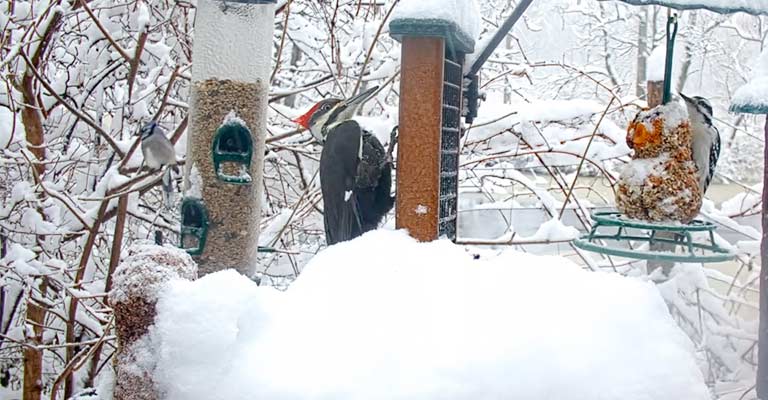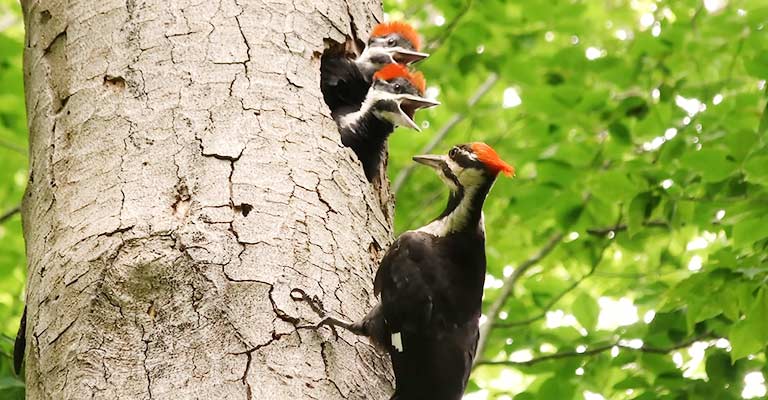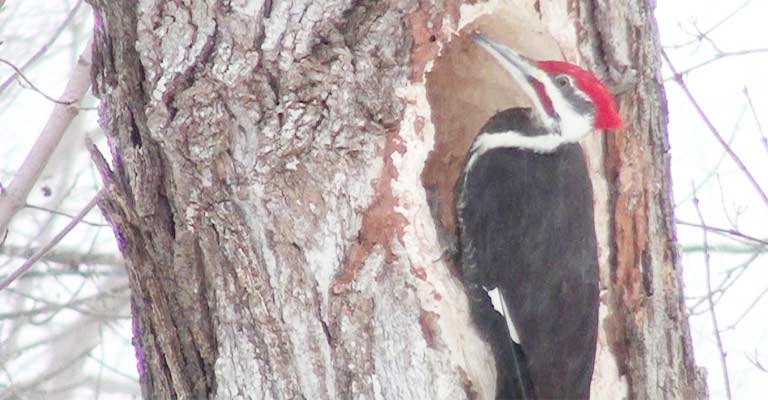As winter blankets the landscape, the vibrant and iconic Pileated Woodpeckers navigate a changing world, adapting their habitats and diets for survival.
Delving into pileated Woodpeckers in winter- where they live & what they eat unveils a fascinating glimpse into the resilience of these majestic birds.
From wooded suburbs to riverine habitats and from insects to sap, their winter journey is a testament to their adaptability and resourcefulness in the face of seasonal challenges.

Pileated Woodpeckers In Winter- Where They Live & What They Eat
Pileated Woodpeckers, magnificent and distinctive, exhibit unique behaviors in winter. This exploration delves into their winter habitats, detailing where they live and their dietary preferences during the colder months.
Mature Forests
Pileated Woodpeckers often choose mature forests with tall trees. The presence of old-growth trees provides suitable nesting sites, and the dense canopy offers protection from the elements, making these woodlands ideal winter refuges.
Wooded Suburban Areas
Surprisingly adaptable, Pileated Woodpeckers extend their range into wooded suburban areas during winter. They may explore parks, large gardens, and wooded neighborhoods, demonstrating a capacity to coexist with human development.
Riverine Habitats
Along riverbanks and water bodies, Pileated Woodpeckers find winter habitats rich in food sources. The combination of water proximity and tree availability makes these areas favorable during colder months.
Mixed Forests
Pileated Woodpeckers are known to thrive in mixed forests, where a variety of tree species provide diverse foraging opportunities. This habitat choice ensures access to an array of insects, larvae, and other winter sustenance.
Deciduous Forests
In deciduous forests, where trees shed their leaves in winter, Pileated Woodpeckers navigate bare branches in search of insects and larvae. These habitats provide a different winter experience compared to evergreen-dominated areas.
Coniferous Forests
Coniferous forests, with their evergreen trees, offer Pileated Woodpeckers shelter and abundant food sources during winter. The thick foliage provides protection, while the trees’ resilience against harsh weather conditions enhances the woodpeckers’ winter survival.
Forest Edges

Pileated Woodpeckers are frequently found in the transitional zones between forests and open areas. These forest edges provide a mix of resources, combining the shelter of wooded regions with the foraging opportunities found in open spaces.
Delve into the delectable array of foods that these majestic birds rely on during winter, showcasing their resourcefulness in finding sustenance:
Insects and Larvae
Despite the chill, Pileated Woodpeckers persistently forage for insects and larvae beneath the bark of trees. Wood-boring beetles, ants, and caterpillars have become sought-after delicacies, providing essential proteins and nutrients.
Berries and Fruits
Winter doesn’t deter Pileated Woodpeckers from relishing the sweetness of berries and fruits. They often explore the branches of berry-bearing shrubs and trees, feasting on a variety of fruits to supplement their diet and add vital energy.
Nuts and Seeds
Pileated Woodpeckers have a knack for extracting nuts and seeds from various tree species. Mast crops such as acorns, beech nuts, and pine seeds become valuable winter resources, offering a rich source of fats and calories.
Sap
Winter sap provides a unique source of sustenance for Pileated Woodpeckers. They skillfully excavate sapwells in trees, savoring the nutrient-rich liquid. This clever adaptation allows them to tap into an unconventional yet essential food source.
Fungi and Mushrooms
Pileated Woodpeckers display a fondness for fungi and mushrooms, especially during winter. The decaying wood of trees becomes a treasure trove for these woodpeckers as they uncover and consume fungi, adding diversity to their winter diet.
Invertebrates in Dead Wood
Dead and decaying wood harbors a wealth of invertebrates, and Pileated Woodpeckers exploit this resource during winter. They methodically excavate into the softened wood, uncovering beetle larvae and wood-boring insects for sustenance.
Spider Webs and Egg Masses
Pileated Woodpeckers showcase their resourcefulness by targeting spider webs and egg masses during winter. This unique dietary choice provides a protein boost, showcasing the woodpeckers’ ability to diversify their food sources when needed.
Pileated Woodpeckers In Winter- How They Nest

In the quiet hush of winter, Pileated Woodpeckers exhibit remarkable nesting behaviors, adapting their shelters to withstand the cold. Explore the ingenious ways these majestic birds create and maintain their nests, ensuring a cozy retreat during the winter months.
Tree Cavities
Pileated Woodpeckers are master excavators, crafting spacious tree cavities for nesting. These cavities serve as winter sanctuaries, providing insulation against the chill and a secure haven for roosting during the night.
Snags and Dead Trees
Dead or decaying trees, known as snags, become natural habitats for Pileated Woodpeckers in winter. They fashion nests in the softer wood of snags, using their powerful bills to create cozy shelters amid the branches.
Abandoned Nest Sites
Pileated Woodpeckers exhibit a clever habit of reusing abandoned nest sites, especially during winter. These sites, whether their own or those of other cavity-nesting birds, offer pre-existing shelter, saving time and energy during the nesting process.
Tree Limbs and Branches
While they are known for excavating cavities, Pileated Woodpeckers also utilize the sheltered spaces among tree limbs and branches for winter roosting. This allows them to huddle close to the tree’s trunk, reducing exposure to winter winds.
High in the Canopy
Pileated Woodpeckers often choose nesting locations high in the canopy, providing an elevated vantage point and increased safety from ground predators. Their nests may be situated on large branches or in the upper reaches of tall trees.
Wooden Utility Poles
In human-altered environments, Pileated Woodpeckers demonstrate adaptability by selecting wooden utility poles for nesting. The softer wood of these poles allows for easier excavation, creating a snug winter refuge near human structures.
Excavated Roost Holes
Beyond traditional nesting, Pileated Woodpeckers craft additional excavated roost holes during winter. These smaller cavities serve as cozy sleeping quarters, allowing them to conserve energy by minimizing exposure to the cold night air.
The nesting strategies of Pileated Woodpeckers in winter showcase their resourcefulness and adaptability. Whether in tree cavities, snags, or high in the canopy, these birds skillfully craft shelters that provide warmth, protection, and a resilient retreat during the winter season.
FAQs
What do Pileated Woodpeckers eat in winter?
During winter, Pileated Woodpeckers consume a diverse diet. Their meals include insects and larvae found beneath tree bark, berries, nuts, seeds, sap, fungi, and even spider webs. This varied diet ensures they obtain essential nutrients for winter survival.
Do Pileated Woodpeckers nest in winter, and where?
Yes, Pileated Woodpeckers exhibit nesting behaviors in winter. They craft nests in tree cavities, snags, and even wooden utility poles. The woodpeckers may also reuse abandoned nest sites, showcasing resourcefulness in creating cozy shelters.
How do Pileated Woodpeckers adapt their nests for winter?
Pileated Woodpeckers adapt their nests for winter by choosing insulated locations, such as tree cavities and snags. These spaces protect from the cold, and the woodpeckers may also create additional roost holes for cozy sleeping quarters during winter nights.
What is unique about the winter habitat of Pileated Woodpeckers?
Pileated Woodpeckers showcase uniqueness in their winter habitats by navigating wooded suburbs, riverine areas, and mixed forests. They may choose high canopy locations, demonstrating adaptability even in human-altered environments.
How do Pileated Woodpeckers use the sap as part of their winter diet?
Pileated Woodpeckers skillfully tap into sap flows during winter, excavating sapwells in trees. This unconventional dietary choice provides additional nutrients and showcases the woodpeckers’ adaptability in utilizing diverse food sources during colder months.
Conclusion
In the quiet serenity of winter, the Pileated Woodpeckers find their niches, transforming diverse habitats into winter havens.
Whether exploring the forested landscapes, tapping into the sap flow, or indulging in a varied diet of insects, berries, and fungi, these woodpeckers embody nature’s brilliance in adaptation.
As winter envelopes their chosen abodes and nourishment sources, the Pileated Woodpeckers endure, leaving a trail of resilience and ecological significance in their wintry wake.